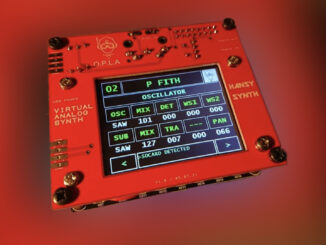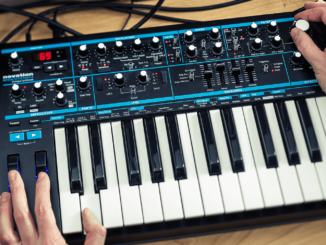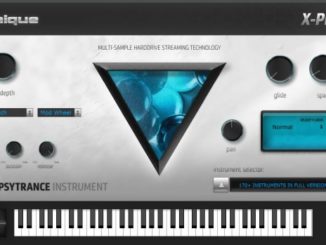Moog revealed the mass production version of its super unique Subharmonicon “harmonic kaleidoscope” Synthesizer with a new design, new functions.
Info first: I should have had a video online today at 6PM (CET), unfortunately, my test device is stuck in Austrian customs. Hope I can show you more soon.
Almost exactly two years ago, Moog presented the Subharmonicon as a DIY exclusive VIP workshop product at the Moogfest 2018. It has now taken two years for Moog to completely re-engineer, to revise, and turn it into a mass product. Visually very beautiful. The new Moog Subharmonicon now looks super chick and is easier to use.
At first glance, the Subharmonicon’s analog engine is very Moog classic: two juicy analog VCOs, a ladder filter, dual envelope generators, and VCA. However, the SH is more than just another classic analog Synthesizer. It has an additional of four Subharmonic oscillators, two 4-step sequencers, and four rhythm generators that make the difference. Moog has here in a very playful way paid tribute to the Mixtur-Trautonium (Joseph Schillinger) and Rhythmicon (Leon Theremin) concepts.
Subharmonicon is semi-modular, has the same shape as the Mother 32 and DFAM but follows a different way. It’s far more experimental and unique. It uses mathematical ratios to tune its Subharmonic oscillators and control the timing o its rhythm generators. It can be described as a polyrhythmic Synthesizer that uses maths to ensure that the tuning and timing remain coherent and musical. Very special are the 4 sub-oscillators that plays the main role here.
Each subharmonic tone is mathematically derived from one of the two main VCOs, giving the resulting chord shapes a beautifully coherent quality. With an onboard quantization, you can dial in perfect intervals every time with selections for multiple tuning systems. Choose from contemporary Equal Temperament settings, the heavenly intervals of Just Intonation, or the unlimited freedom of no quantization at all.
The Mixtur-Trautonium created subharmonics by dividing the frequency of its primary oscillator, while the Rhythmicon created polyrhythms that were multiplications of its primary tempo. These concepts of subharmonics and polyrhythms from the historic roots of the Moog Subharmonicon.
Chord Shapes Animation
The so-named chord shapes can be animated with the two 4-step sequencers which are clocked by the rhythm generators which allows you to create layers of timings and rhythms. The synth is capable of creating a wide range of different sounds: from very complex rhythmic melodic patterns, pads, percussion or even noise.
Like the two other Moog semi-modular synths, it comes with a big patch bay within a total of 32 inputs & outputs. With these, you can incorporate the SH in your Mother-32/DFAM or any other modular system. To be honest with you: the Subharmonicon is one of the most difficult, describable synthesizers for me so far.
The concept is very special and different. I can only recommend Loopop’s in-depth video tutorial and review that goes into the details of this new synth. Extremely exciting Synthesizer, in my opinion, one that you really have to learn and to master. Try & Error is the motto here.
Moog Subharmonicon will be available end of May for 849€ (Europe).
More information here: Moog Music




chic